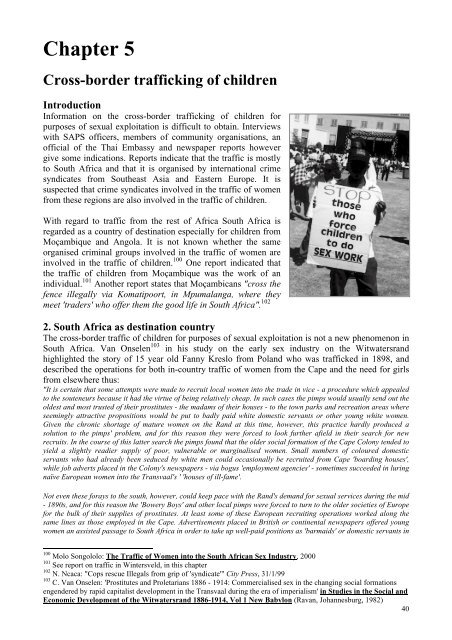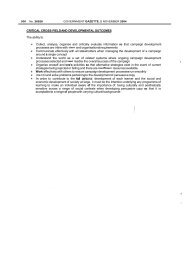The trafficking of children for purposes of sexual exploitation
The trafficking of children for purposes of sexual exploitation
The trafficking of children for purposes of sexual exploitation
You also want an ePaper? Increase the reach of your titles
YUMPU automatically turns print PDFs into web optimized ePapers that Google loves.
Chapter 5<br />
Cross-border <strong>trafficking</strong> <strong>of</strong> <strong>children</strong><br />
Introduction<br />
In<strong>for</strong>mation on the cross-border <strong>trafficking</strong> <strong>of</strong> <strong>children</strong> <strong>for</strong><br />
<strong>purposes</strong> <strong>of</strong> <strong>sexual</strong> <strong>exploitation</strong> is difficult to obtain. Interviews<br />
with SAPS <strong>of</strong>ficers, members <strong>of</strong> community organisations, an<br />
<strong>of</strong>ficial <strong>of</strong> the Thai Embassy and newspaper reports however<br />
give some indications. Reports indicate that the traffic is mostly<br />
to South Africa and that it is organised by international crime<br />
syndicates from Southeast Asia and Eastern Europe. It is<br />
suspected that crime syndicates involved in the traffic <strong>of</strong> women<br />
from these regions are also involved in the traffic <strong>of</strong> <strong>children</strong>.<br />
With regard to traffic from the rest <strong>of</strong> Africa South Africa is<br />
regarded as a country <strong>of</strong> destination especially <strong>for</strong> <strong>children</strong> from<br />
Moçambique and Angola. It is not known whether the same<br />
organised criminal groups involved in the traffic <strong>of</strong> women are<br />
involved in the traffic <strong>of</strong> <strong>children</strong>. 100 One report indicated that<br />
the traffic <strong>of</strong> <strong>children</strong> from Moçambique was the work <strong>of</strong> an<br />
individual. 101 Another report states that Moçambicans "cross the<br />
fence illegally via Komatipoort, in Mpumalanga, where they<br />
meet 'traders' who <strong>of</strong>fer them the good life in South Africa". 102<br />
2. South Africa as destination country<br />
<strong>The</strong> cross-border traffic <strong>of</strong> <strong>children</strong> <strong>for</strong> <strong>purposes</strong> <strong>of</strong> <strong>sexual</strong> <strong>exploitation</strong> is not a new phenomenon in<br />
South Africa. Van Onselen 103 in his study on the early sex industry on the Witwatersrand<br />
highlighted the story <strong>of</strong> 15 year old Fanny Kreslo from Poland who was trafficked in 1898, and<br />
described the operations <strong>for</strong> both in-country traffic <strong>of</strong> women from the Cape and the need <strong>for</strong> girls<br />
from elsewhere thus:<br />
"It is certain that some attempts were made to recruit local women into the trade in vice - a procedure which appealed<br />
to the souteneurs because it had the virtue <strong>of</strong> being relatively cheap. In such cases the pimps would usually send out the<br />
oldest and most trusted <strong>of</strong> their prostitutes - the madams <strong>of</strong> their houses - to the town parks and recreation areas where<br />
seemingly attractive propositions would be put to badly paid white domestic servants or other young white women.<br />
Given the chronic shortage <strong>of</strong> mature women on the Rand at this time, however, this practice hardly produced a<br />
solution to the pimps' problem, and <strong>for</strong> this reason they were <strong>for</strong>ced to look further afield in their search <strong>for</strong> new<br />
recruits. In the course <strong>of</strong> this latter search the pimps found that the older social <strong>for</strong>mation <strong>of</strong> the Cape Colony tended to<br />
yield a slightly readier supply <strong>of</strong> poor, vulnerable or marginalised women. Small numbers <strong>of</strong> coloured domestic<br />
servants who had already been seduced by white men could occasionally be recruited from Cape 'boarding houses',<br />
while job adverts placed in the Colony's newspapers - via bogus 'employment agencies' - sometimes succeeded in luring<br />
naïve European women into the Transvaal's ' 'houses <strong>of</strong> ill-fame'.<br />
Not even these <strong>for</strong>ays to the south, however, could keep pace with the Rand's demand <strong>for</strong> <strong>sexual</strong> services during the mid<br />
- 1890s, and <strong>for</strong> this reason the 'Bowery Boys' and other local pimps were <strong>for</strong>ced to turn to the older societies <strong>of</strong> Europe<br />
<strong>for</strong> the bulk <strong>of</strong> their supplies <strong>of</strong> prostitutes. At least some <strong>of</strong> these European recruiting operations worked along the<br />
same lines as those employed in the Cape. Advertisements placed in British or continental newspapers <strong>of</strong>fered young<br />
women an assisted passage to South Africa in order to take up well-paid positions as 'barmaids' or domestic servants in<br />
100 Molo Songololo: <strong>The</strong> Traffic <strong>of</strong> Women into the South African Sex Industry, 2000<br />
101 See report on traffic in Wintersveld, in this chapter<br />
102 N. Ncaca: "Cops rescue Illegals from grip <strong>of</strong> 'syndicate'" City Press, 31/1/99<br />
103 C. Van Onselen: 'Prostitutes and Proletarians 1886 - 1914: Commercialised sex in the changing social <strong>for</strong>mations<br />
engendered by rapid capitalist development in the Transvaal during the era <strong>of</strong> imperialism' in Studies in the Social and<br />
Economic Development <strong>of</strong> the Witwatersrand 1886-1914, Vol 1 New Babylon (Ravan, Johannesburg, 1982)<br />
40
















